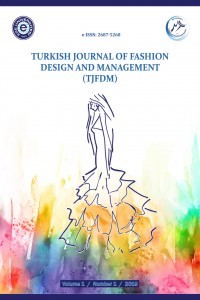TEKSTİL TASARIM STÜDYOSUNDA TEMA BASKI TEKNİĞİYLE AFRİKA BASKI KUMAŞLARININ SİMÜLASYONU.
Afrika baskısı, kumaşlar, simülasyon, serigrafi, stüdyo
SIMULATION OF AFRICAN PRINT FABRICS USING SCREEN PRINTING TECHNIQUE IN THE TEXTILE DESIGN STUDIO.
African print, fabrics, simulation, screen printing, studio,
___
- Adeloye, A. A. (2016). Investigation into Studio Handcrafted Techniques in the Design and Production of Simulated African Prints, unpublished masters thesis, Federal University of Technology, Akure.
- Adeloye, A. A. (2021). Evaluation of Design Praxis in African Prints Production in Southwest Nigeria, unpublished PhD thesis, Federal University of Technology, Akure.
- Akinwumi, T. M. (2008). The “African print” hoax: machine produced textiles jeopardize African print authenticity. The Journal of Pan African Studies, 2(5), 179-192.
- Amankwah, A. M., & Howard, E. K. (2013). Technical limitations of African prints and their implications on garment construction. Journal of Science and Technology, 33(1), 75–83.
- Chichi, C., Howard, E. K., & Baines, E. (2016). Assessment of consumer preference for the use of African wax prints. International Journal for Innovation Education and Research, 4(10), 1–10.
- Essel, O. Q. (2017). Deconstructing the concept of “ African print ” in the Ghanaian experience. Africology: The Journal of Pan African Studies, 11(1), 37–51.
- Hagen-jurkowitsch, S., & Alexander, S. (2016). An analysis of the current denotation and role of wax & fancy fabrics in the world of African textiles. International Journal of Management Cases, 12(3), 3-18.
- Hagen-jurkowitsch, S., & Alexander, S. (2016). An analysis of the current denotation and role of wax & fancy fabrics in the world of African textiles. International Journal of Management Cases, 12(3), 3-18.
- Ogunduyile, S.R (2001). Cottage dyeing industry and environmental hazards created by the use of commercial dyes and chemicals, Journal of Arts and Ideas. 6(7), 106-114.
- Onwuakpa, L. E. (2016). Textile designs and fashion as strategic resource tools for economic development in Nigeria. International Journal of Arts and Humanities, 5(2), 111–119.
- Tolulope, A. M., & Babatunde, O. (2013). The resurgence of ankara materials in Nigeria. Journal of Education and Practice, 4(17), 166–170.
- Uqalo, R. (2015). The African print market. Uqalo Advisory, 1(1), 1-35.
- Wilson, J. (2001). Principles , processes and practice. CRC Press.
- Yayın Aralığı: Yılda 3 Sayı
- Başlangıç: 2019
- Yayıncı: Ege Üniversitesi
DERİ ÜZERİNE EBRU BOYAMA TEKNİĞİNİN ÖRNEK ÇALIŞMA BAĞLAMINDA DEĞERLENDİRİLMESİ
Dilara Nur ATALAN, Özcan DEMİR, Ebru CORUH
Dilara Nur ATALAN, Bünyamin ÜZÜMCÜ
KÜLTÜRLER ARASI ETKİLEŞİMDE MODA: BİZANS PELERİNİ İLE GÜNEY AMERİKA PANÇOSU
Nazan AVCIOĞLU KALEBEK, Altınay SAYAR, Figen KÕSE
TEKSTİL TASARIM STÜDYOSUNDA TEMA BASKI TEKNİĞİYLE AFRİKA BASKI KUMAŞLARININ SİMÜLASYONU.
Adebayo Abiodun ADELOYE, Oluwatoyin Funke AKİNNİBOSUN, Tope Dare KAYODE, Afeez Babatunde SİYANBOLA, Adedola Olayinka ADEYEMİ
